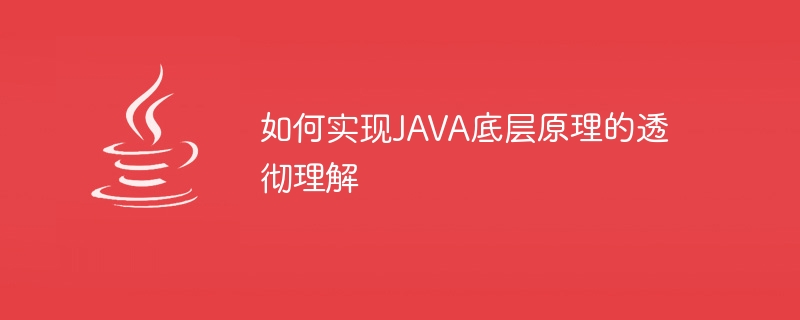

How to achieve a thorough understanding of the underlying principles of JAVA requires specific code examples
As a high-level programming language, Java is widely used in software development in various fields. However, for some developers who are interested in learning and researching the underlying principles of Java in depth, just understanding the surface knowledge of Java is not enough. To truly understand the underlying principles of Java, you need to deeply study the operating mechanism of the Java Virtual Machine (JVM) and the compilation and execution process of Java programs.
First of all, we need to understand the operating mechanism of the Java Virtual Machine (JVM). When a Java program is running, the source code is first compiled into a bytecode file (.class file) through the compiler, and then the bytecode file is interpreted and executed by the JVM. Therefore, to understand the underlying principles of Java, you need to have a certain understanding of the structure and interpretation and execution process of bytecode files.
The bytecode file consists of a series of bytecode instructions, each instruction corresponds to a specific operation. In order to better understand the meaning and execution process of bytecode instructions, we can use Java bytecode viewing tools, such as Javap command or decompilation tool, to view the compiled bytecode file and the corresponding Java code .
The following uses a specific example to illustrate how to use the Java bytecode viewing tool to deeply understand the underlying principles of Java. Suppose we have the following simple Java code:
public class HelloWorld {
public static void main(String[] args) {
System.out.println("Hello, World!");
}
}We can compile this code into a bytecode file through the javac command:
javac HelloWorld.java
Then, use the javap command to view the compiled Bytecode file:
javap -c HelloWorld.class
By viewing the bytecode file, we can see the specific bytecode instructions and corresponding operations. For example, in the bytecode file corresponding to the above code, we can see the following results:
public class HelloWorld {
public HelloWorld();
Code:
0: aload_0
1: invokespecial #1 // Method java/lang/Object."<init>":()V
4: return
public static void main(java.lang.String[]);
Code:
0: getstatic #7 // Field java/lang/System.out:Ljava/io/PrintStream;
3: ldc #13 // String Hello, World!
5: invokevirtual #19 // Method java/io/PrintStream.println:(Ljava/lang/String;)V
8: return
}By analyzing the bytecode instructions, we can see that in the main method, static is obtained through the getstatic instruction and the ldc instruction. Domain java/lang/System.out and literal Hello, World!, and then call the println method of the PrintStream class through the invokevirtual instruction to output.
Through the above examples, we can see that by in-depth understanding and analysis of bytecode instructions, we can have a clearer understanding of the underlying operating mechanism of Java programs.
In addition to analyzing bytecode files, we can also have a deeper understanding of the underlying principles of Java by writing some underlying code. For example, we can write a simple ClassLoader to manually load the bytecode file and execute the code in it:
import java.io.IOException;
import java.nio.file.Files;
import java.nio.file.Path;
import java.nio.file.Paths;
public class CustomClassLoader extends ClassLoader {
public static void main(String[] args) throws ClassNotFoundException, IllegalAccessException, InstantiationException {
CustomClassLoader customClassLoader = new CustomClassLoader();
Class<?> helloWorldClass = customClassLoader.findClass("HelloWorld");
Object helloWorldObject = helloWorldClass.newInstance();
helloWorldClass.getDeclaredMethods()[0].invoke(helloWorldObject, null);
}
@Override
protected Class<?> findClass(String name) throws ClassNotFoundException {
byte[] bytes = loadClassFromFile(name);
return defineClass(name, bytes, 0, bytes.length);
}
private byte[] loadClassFromFile(String fileName) {
Path path = Paths.get(fileName.replace(".", "/") + ".class");
try {
return Files.readAllBytes(path);
} catch (IOException e) {
e.printStackTrace();
}
return null;
}
}By customizing the ClassLoader class, we can manually load the bytecode file of the HelloWorld class and create the An instance of a class, and finally calls its methods.
To summarize, to achieve a thorough understanding of the underlying principles of Java, we need to deeply study the operating mechanism of the Java Virtual Machine (JVM), as well as the compilation and execution process of Java programs. By using Java bytecode viewing tools, we can view compiled bytecode files and gain a deep understanding of Java's underlying principles by analyzing bytecode instructions. In addition, we can also gain a deeper understanding of the underlying principles of Java by writing some low-level code, manually loading bytecode files and executing the code in them. Through continuous learning and practice, we can gradually improve our understanding and mastery of the underlying principles of Java.
The above is the detailed content of How to achieve a thorough understanding of the underlying principles of JAVA. For more information, please follow other related articles on the PHP Chinese website!




